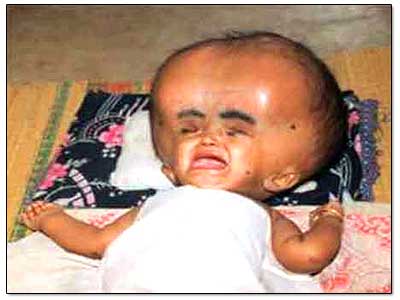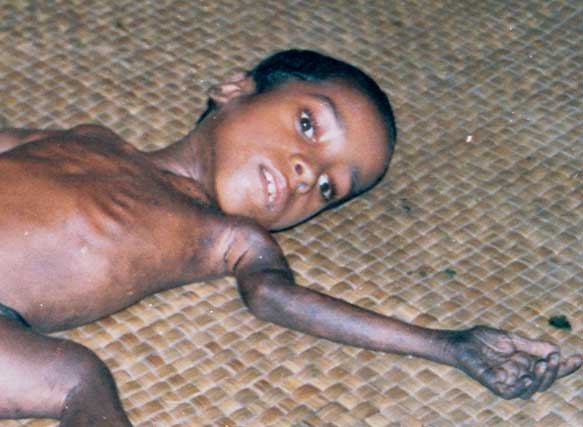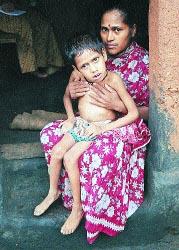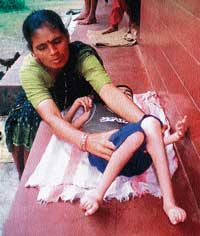Devil’s Playground
By Prabhat Sharan
16 December, 2010
The Verdict Weekly

A random epidemiological survey carried out last month jointly by the
state government’s health and agriculture department, revealed that
2,210 victims of Endosulfan poisoning in Kasargod, with nearly 200
deaths due to cancer in last eight years
The Northern border of God’s Own Country - Kerala has become a Devil’s
Playground with sprinklers and aircraft spewing slow fuse painful
death amongst Kasargod district natives. The death spit that has
transmogrified the green ribbons of Kerala into killing fields is the
most-banned pesticide in the world-Endosulfan. Ironically, though
banned by the state government of Kerala in 2005, following protests,
the Union government continues with its deranged experiment, keeping
its thumb on the fast-forward button. Quoting orchestrated,
quarter-baked callous and indifferent researchers, the Union
government has once again appointed a committee into the matter. The
result: Coffers of manufacturers continue to over flow and so do the
numbers of coffins in the districrt.

For over a decade, Kasargod has been witnessing a silent genocide
through the spraying of Endosulfan on its fields. Though a popular
pesticide amongst farmers growing cashew crops, the toxicity of the
chemical leads not just in a slow painful fatality and deformation
amongst adults, but the exposure attacks neo-natal infants by mutating
the growth pattern.
Countless researches, surveys and plethora of reports have indexed
the adverse effect of the usage of Endosulfan - children born with
stag-horn limbs, scale-like skin, protruding tongues, eye deformities,
extra fingers and toes, cleft palates, club feet and harelips; of
those suffering from hydrocephalus (progressive enlargement of the
head, convulsion and mental disability), dermatitis, renal diseases,
respiratory disorders, cognitive and emotional deterioration, memory
loss, impairment of visual-motor coordination, blindness, cerebral
palsy, epilepsy and infertility; of young girls and boys who have
undergone multiple surgery and artificial limb modification; of young
mothers who have opted for repeated abortions instead of giving birth
to headless/limbless/deformed children; of young men and women who
look like children; and, of children who look like stunted
grandparents.”

However, despite such tragic outcome, the Indian government has
refused to concede to the wails and cries of people. Ironically, even
though the neighbouring countries, looked down upon as less advanced,
have banned the usage of Endosulfan long, long time back, India
continues to be the world’s largest consumer, thanks to the Union
government’s patronage to the manufacturing companies.
Kerala agriculture minister Mullakkara Ratnakaran conceding the
deathly effects, pleads helplessness in the face of smugglers who
carry out a thriving clandestine intra-state trade of Endosulfan. “The
Kerala government banned its usage in 2005, but then it is readily
available in the neighbouring states,” he stated to newspersons.
Prof M A Rehman, an anti-Endosulfan activist, talking to THE VERDICT,
from Kasargod shrugs away the dubious stance of Kerala politicians.
Pointing out that after the October 15th meeting in Stockholm of
Persistent Organinc Pollutants Review Committee, wherein scores of
countries acquiesced to Endosulfan ban demand, Union Minister for
Agriculture K V Thomas (hailing from Kerala) had the temerity to root
for the pesticide usage. Of course, Thomas was just parroting the
Indian stand at Stockholm.



But then Thomas is not alone in this dubious dance. According to
Rehman, Kerala government is also playing a dubious game in the entire
issue. “Since it is well documented that hundreds of people have died
due to Endosulfan exposure and thousands are suffering with slow
fulminating serious latent ailments but Kerala government has come out
with token payment for victims, terming it as ‘relief rehabilitation
package”.
“First of all the very payment is so less that it is not worth
mentioning and then this verbal jugglery, the term “compensation,’ is
not used because that will drill the nail straight into government
lies.”
Endosulfan Action Committee (EAC,) a conglomeration of organisations
working for the relief and rehabilitation of the affected people, in
its study state that there are at least “8,000 to 9,000 victims still
suffering the debilitating effects of the aerial spraying of
Endosulfan done mainly in the three cashew plantations (total area
4,715 hectares) owned by the Plantation Corporation of Kerala (PCK)
until 2002, when a ban was first imposed by the Kerala High Court.”
Today in Kasargod district, PCK is looked down upon as a cannibal
beast out to suck the blood of villagers. Though the State Agriculture
Department started cashew trees in 1963 in the region, it was in 1978
that PCK started taking over the plantations.
In 1980s, PCK started its death spray thrice a year, in the cashew
plantation hills. For the state-run company it was cost-effective
annihilation of tea mosquito bug which causes yield losses in cashew
plantations- a major forex churner for the government.
And since then Kasargod villagers who initially watched the
jaw-dropping spraying of chemical by the helicopters never realized
the slow-death that was enveloping their skin, water ways, food and
even fuel wood.
According to EAC reports, “the PCK ignored stipulations that such
aerial spraying of pesticides should be done very close to the canopy
level or that the same pesticide should not be used continuously for
such a long time in an area. Copters often flew much above the
stipulated three metres above the cashew trees to avoid power lines
and thus caused the spread of the highly toxic chemical to a wider
area. The water and soil in the villages were contaminated severely.
Even the possibility of the bugs acquiring immunity because of
long-term exposure was not considered by the PCK.”
Several news reports documented the warning signals - dead birds,
frogs and fish in the streams and rivulets; cattle, and wildlife found
dead in the plantation areas; and local people experiencing acute
endosulfan toxicity symptoms after the spraying sorties over their
villages. But the Centre as well as the State as well as PCK ignored
and shrugged it off as ‘alarmist studies.’
By late 1990s studies by independent organizations started revealing
residues of Endosulfans in blood and breast milk of villagers and its
linkages with cancer, and reproductive and nervous system disorders
along with psychiatric problems and visual impairment amongst
children.
A public outcry and plethora of court cases forced the government to
impose a temporary ban which within a year was adjusted to just aerial
spraying. However, in August 2002, the Kerala High Court ordered an
interim ban on the usage following following an epidemiological study
conducted by the National Institute of Occupational Health (NIOH,)
Ahmedabad, linking the eruption of symptoms plaguing the people in the
region to the use of the pesticide. The interim ban sparked of studies
and committees by successive governments in a bid to get a green
signal for Endosulfan usage. The question of a total ban on Endosulfan
in Kerala continues to swing on the pendulum from one end to the
other, with government-appointed committees trying to give a clean
chit in opposition to the empirical evidence.
Ironically, even as the opposition to Endosulfan usage is growing
world-over the morbidity patterns from other districts like Idukki,
Wayanad and Palakkad as well as Dakshina Kannada reveals a similar
sinister path indicating the increasing usage of the pesticide. This
finding is not startling given the clout which Indian pesticide
manufacturing cartel wields. India is one of the largest producers of
pesticides in the world and continues to be the largest producer and
user of Endosulfan, with reportedly over 60 manufacturers and
formulators involved in its production and sale. Allegations are rife
about the nexus between pesticide manufacturing cartel and government
and regulatory bodies.
For example, India’s top three manufacturers - among them the public
sector Hindustan Insecticides Ltd. (HIL), Kochi – together produced
9,500 tonnes of Endosulfan between 2007 and 2008, and 5,500 tonnes of
it was used domestically, according to one report.
HIL, ironically, is based in the heavily polluted industrial belt on
the banks of the Periyar river in central Kerala and is a Government
of India enterprise. It is today one of the largest producers of
endosulfan in India, manufacturing 1,500 tonnes of endosulfan
(technical grade) and 1,900 kilolitres of liquid Endosulfan a year,
both for use within India (not in Kerala) and for export. But there
are equally prominent manufacturers of “crop protection chemicals” in
the private sector too, such as Excel Industries Ltd, EID Parry and
Coromandel Fertilizers Ltd. Interestingly, even as the Indian
government has pulled out all the stops to block the international
conventions seeking to ban Endosulfan, an MNC like Bayer has gone
ahead and stopped its production this year.
The Endosulfan victims of Kasargod are once more at epicentre of a
chemical quake ripping through their lives. And people from Kasargod
are hoping in words of Dr Meriel Watts, co-ordinator, Pesticide Action
Network Aotearoa New Zealand, “We can only hope that by then the
Indian government will have come to realise the enormous embarrassment
to it, that is being caused by its delegate, and by its conflict of
Interest: the Indian government owns Hindustan Industries, one of the
manufacturers of endosulfan. This type of conflict of interest is
unheard of in international conventions, and India’s behaviour is
threatening to wreck both the conventions."
Factfile: Usage history and ban
ENDOSULFAN HAS been used in agriculture since the early 1950s, but is
now banned in over 62 countries, including those in the European Union
and, following widespread protests, United States of America too
banned its usage due to its high toxicity to humans and other
organisms and its quality of persistence in the environment.
Incidentally, the USA ban was announced by its Environmental
Protection Agency (EPA) on June 7, 2010, with the following words:
“The EPA is taking action to end all uses of the insecticide
Endosulfan in the United States. Endosulfan, which is used in
vegetables, fruits, and cotton, can pose unacceptable neurological and
reproductive risks to farm-workers and wildlife and can persist in the
environment.”
It is also banned in Sri Lanka and several Asian and West African
nations due to confirmed evidence of its acute toxicity, potential for
bioaccumulation, and role as an endocrine disruptor.
Effects and Symptoms
Endosulfan is an organochlorine pesticide like the widely banned DDT
and Dieldrin. Since they tend to persist in the environment and
bio-accumulate in humans and other animals –in liver, kidney and fatty
tissues-such pollutants are of concern “because of their long-term
subtle effects on hormones, the immune systems and reproduction,”
according to a study carried out by UK-based Environmental Justice
Foundation (EJF.)
The spraying caused unusually high incidence of central nervous system
disorders like cerebral palsy, congenital neurological disorders,
cancers, body deformations, reproductive disorders and miscarriages.
Male school children exposed to the pesticide Endosulfan showed
delayed sexual maturity, according to a study published in
Environmental Health Perspectives (EHP).
Producers: India is by far the largest manufacturer of endosulfan,
with the state-owned Hindustan Insecticides Ltd (HIL) and two private
companies producting the pesticide. China manufactures small amounts,
and Israel also manufacturers an unknown amount. In fact an Israeli
company, Makhteshim Agan, has just started manufacturing pesticides in
Andhra Pradesh; it is not yet known whether they produce endosulfan or
not.
Though China supported India at the last POPs Review Committee
meeting, its support may not last as the communist country has a
better record of banning highly toxic pesticides.
Prabhat Sharan is a Senior Journalist with interest in social, working
class, wild-life conservation, media, philosophical and literary
studies. He can be contacted at [email protected]


